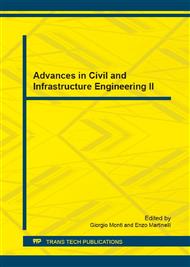p.128
p.135
p.141
p.146
p.156
p.166
p.173
p.183
p.191
A Novel Conceptual Approach for Predicting the Mechanical Properties of Recycled Aggregate Concrete
Abstract:
The construction sector is more and more committed to reduce its environmental impacts. One of the key actions undertaken in the last decade deals with the ability of turning construction and demolition waste into new raw materials. For instance, the use of recycled aggregates for producing new concrete was one of the most investigated. Thus, in the last decade, plenty of researches were involved in project on characterising the mechanical behaviour of concrete made with recycled aggregates. However, these projects were mainly experimental in nature and generally led to merely empirical formulations. Conversely, this paper is intended at providing a contribution for predicting the mechanical properties of Recycled Aggregates Concrete (RAC). Particularly, it aims at quantifying the effect of replacing ordinary aggregates with Recycled Concrete Aggregates (RCA) on the resulting compressive strength of RAC. To this end, a conceptual model considering both the relevant physical properties of regular and recycled aggregates, including the attached mortar content, and the hydration reactions of Portland cement paste is proposed. The actual predictive capacity of the proposed model is assessed through an experimental validation against experimental tests carried out on several concrete batches produced with various values for the different keys parameters, such as the nominal water-to-cement ratio, the aggregates replacement ratio and the initial moisture condition of aggregates. Both the experimental data and the theoretical formulations proposed in this paper stem out from the inter-university collaboration developed as part of the EU funded EnCoRe Project (www.encore-fp7.unisa.it).
Info:
Periodical:
Pages:
156-165
Citation:
Online since:
July 2016
Authors:
Price:
Сopyright:
© 2016 Trans Tech Publications Ltd. All Rights Reserved
Share:
Citation:


